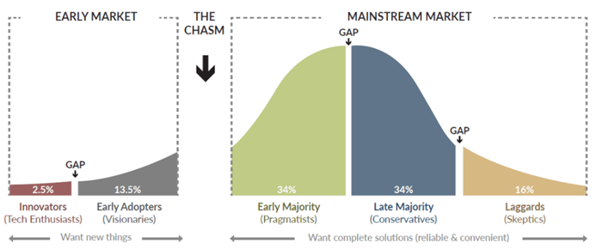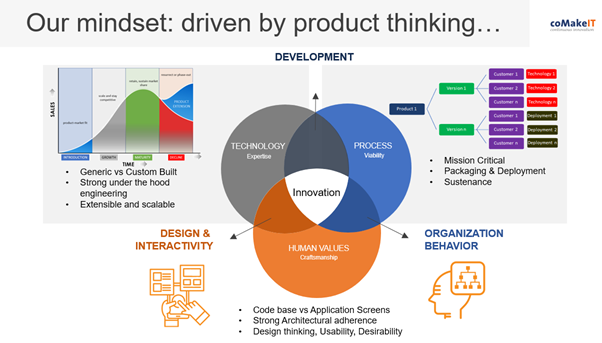-AMAZONPOLLY-ONLYAUDIO-START- Hello and welcome to coMakeIT’s audio blog coMakeIT is software product engineering company that helps in accelerating product innovation, modernize aging applications, and productize best practices into new software IP. Founded by a core team of professionals with decades of experience in building enterprise-scale, sophisticated software products for global markets, we provide a unique blend of software craftsmanship, technology stewardship and product-thinking. We are excited to bring you the audio format you of our popular blogs so you can tune in whenever you find conveniient. Feel free to subcribe to our feed and share with folks who would love to stay updated with latest trends in Software industry. Todays blog topic is -AMAZONPOLLY-ONLYAUDIO-END-
Cheaper and better technology is creating a more connected world in this age of digital revolution. According to Cisco, 500 billion devices are expected to be connected to the internet by 2030. The falling cost of technologies such as robotics, artificial intelligence and data analytics is beginning to dramatically alter today’s industries. The combinatorial effect of technologies, such as mobile, cloud, sensors, analytics, and the Internet of Things, is manifesting in creation of newer and newer innovative software products. This appeal is creating a ‘gold rush’ for both ISV’s and enterprises alike further accelerating the pace of digital disruption.
As of August 2021, there are around 800+ unicorns (ref: CBInsights) around the world and many more striving for Unicorn status – with many of them in Fintech, Artificial Intelligence, EdTech, Auto and Transportation industry verticals. These are game changers but will all of them sustain and cross the chasm?
Crossing the chasm is the leap from a little-known and exploratory product status towards mass adoption and well-known status. It’s the opportunity for hyper-growth and market success!
Amidst the substantial change due to digital disruption, the foundation models for product development and product marketing have traditionally been the same:
Product Life Cycle – Stages
A smooth bell curve broadly divided into 4 different stages viz., introduction, growth, maturity, decline or resurrection. The model suggests the way to develop a product is to work the curve from left to right, progressively enhancing the product with each stage serving as a foundational building block for the next. A product moves within and across these stages through multiple ‘continuous’ release cycles.

Customer mentalities around product adoption
A smooth bell curve of high-tech customers, progressing from Innovators, Early Adopters, Early Majority, Late Majority, and finally Laggards. The model suggests the way to develop a market is to work the curve from left to right, progressively winning each group of users, using each "captured" group as a reference for the next.

A careful observation shows how closely the product adoption cycle follows the product development cycle and how inter-related and inter-dependent product development and adoption are. Often, successful adoption of a product fuels further innovation and product enhancements.
Geoffrey Moore in his book “Crossing the Chasm, Marketing and Selling High-Tech Products to Mainstream Customer”, highlights the challenges in launching a hi-tech product. He offers time tested insights into the problems and dangers facing growing software companies, and a blueprint for survival. Moore demonstrates the cracks/gaps in the product adoption curve, between each phase of the cycle. Each phase caters to a certain user persona and each of these user groups have different buying objectives and expectations.
The gap signifies the difficulty any group will have in accepting a new product if it is presented the same way as it was to the group to its immediate left. The largest crack, big enough to be considered a chasm, is between the Early Adopters and the Early Majority. Many (most) high tech ventures fail trying to make it across this chasm.
Now, let’s dive into the reasons contributing to this chasm. The fundamental reason is the difference in the mindsets of “Early Adopters” and “Early Majority”. The Early Adopters are visionaries who are driven by a ‘dream’ while the Early Majority are pragmatists. Typical characteristics and how these profiles would like to engage is presented below:
| Early Adopters (Visionaries) |
|
| Early Majority (Pragmatists) |
|
Succeeding with the visionaries brings a reputation for being a highflyer with a hot product. However, the real revenue impetus and financial benefits come from the more prudent souls who do not want to be pioneers. The success mantra lies in focussed efforts to segment, segment and segment the playing field, identify a key market space, create that market leading product, and develop the market.
So, it is extremely critical to cross the chasm and cross it quickly. It’s the cusp for exponential growth. Crossing the chasm quickly calls for focus on strategy, alignment, and diligent execution in the areas of marketing, product management & product development. By all means, a very complex affair if to be done all alone. Meaningful alliances and partnerships driven by product thinking mindset help a lot here.
coMakeIT is a reliable and experienced product engineering services provider. Over the last 14+ years, coMakeIT has co-Created products together with several ISV’s and made them successful. With product mindset in its DNA, we have proven credentials to create the ‘whole product’, by thinking through ‘customer’s’ problems– and solutions– in their entirety.
We strive to develop high quality products by harmonizing Innovation & Time-to-Market goals with globally distributed but fully integrated Teams. With a strong emphasis to create generic products (not custom applications), we understand the importance of under-the-hood engineering to create well-engineered, scalable, extensible, and easy to deploy products. This includes the core product plus everything else needed to achieve the compelling reason to buy for the consumer.

We will enable you to acquire expertise, build additional resources, minimize development costs, accelerate your time to market, and above all boost bottom lines by allowing you to focus on new competencies and go-to-market activities.
Earning the pragmatist buyers within a given vertical market, will help you build a loyal customer base, who even go out of their way to help you succeed. When this happens, the cost of sales goes way down, a reference adds to another, ultimately moving the needle up from opportunistic sales driven approach to a concrete market driven approach.
So, what are you waiting for? Cross the chasm by partnering with coMakeIT!




